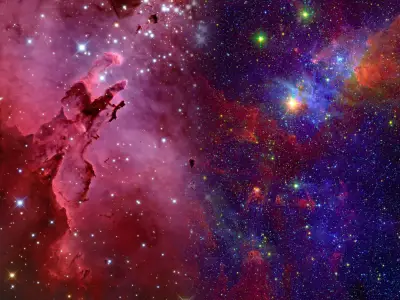Canis Minor, Latin for “the Little Dog,” is one of the simplest yet most fascinating constellations you’ll come across. It may be small, but there’s a lot to learn about this stellar formation and its place in the night sky. Let's explore this fascinating constellation and learn what makes it so intriguing.
Jump to:
- What is the Canis Minor Constellation?
- What Does Canis Minor Look Like?
- How Far is the Canis Minor Constellation from Earth?
- What is the Myth Behind Canis Minor?
- Canis Minor’s Stars
- Nebulae in the Canis Minor Constellation
- How to Find Canis Minor in the Sky
- Interesting Facts About Canis Minor
- Study Astronomy for £29
Recommended for you!
Best SellersWhat is the Canis Minor Constellation?
Canis Minor, which translates to “Little Dog” in Latin, is one of the 88 modern constellations recognised today. It’s relatively easy to spot, despite being made up of only two major stars: Procyon and Gomeisa. While simple in its design, the constellation has interesting connections to astronomy and mythology.
What is the Difference Between Canis Major and Canis Minor?
The difference between Canis Major and Canis Minor is quite pronounced. Canis Major, “the Big Dog,” is famous for hosting Sirius, the brightest star in the night sky. It’s a larger constellation and much easier to spot. In contrast, Canis Minor is smaller, with fewer stars and a simpler outline. However, the two constellations are related in mythology and share the theme of faithful canine companions to Orion, the hunter.
Is Canis Minor a Zodiac Constellation?
Canis Minor is not part of the zodiac constellations, which are the twelve-star formations through which the Sun appears to pass over the course of a year. However, it remains an important constellation in both astronomy and mythology, particularly for its association with the winter night sky and its proximity to more famous constellations.
What Does Canis Minor Look Like?

Canis Minor is a simple constellation made up of two main stars: Procyon and Gomeisa. It doesn’t form an elaborate shape, but rather a subtle line that represents a small dog. This makes Canis Minor one of the easiest constellations to identify, especially on a clear winter night.
How Far is the Canis Minor Constellation from Earth?
The stars that make up Canis Minor are relatively close to Earth in astronomical terms. Procyon, the brightest star in Canis Minor, is only about 11.4 light-years away, making it one of our nearest stellar neighbours. Gomeisa, the second-brightest star, is farther away at approximately 170 light-years.
What is the Myth Behind Canis Minor?

Canis Minor has an interesting place in Greek mythology. The constellation is often associated with the story of Orion, the hunter, and is depicted as one of his loyal hunting dogs. Alongside Canis Major, the "Big Dog," Canis Minor is thought to have accompanied Orion during his celestial hunts.
Another interpretation links Canis Minor to the myth of Maera, the dog of Icarius, a figure from Greek mythology. After a tragic incident involving Dionysus and the death of Icarius, Maera was placed in the sky as a constellation. This myth highlights themes of loyalty and loss, giving Canis Minor a poignant backstory.
Canis Minor’s Stars
Canis Minor is best known for its two main stars, Procyon and Gomeisa:
- Procyon (Alpha Canis Minoris): The brightest star in Canis Minor, Procyon is the eighth-brightest star in the entire sky. It’s a binary star system, consisting of Procyon A, a bright main-sequence star, and Procyon B, a faint white dwarf. Procyon’s name means “before the dog” because it rises just before Sirius, the "Dog Star" of Canis Major.
- Gomeisa: The second-brightest star, Gomeisa, is a blue-white star that adds a subtle but noticeable shimmer to the constellation. It may not be as famous as Procyon, but it completes the constellation’s “Little Dog” image.
Nebulae in the Canis Minor Constellation

Unlike some other constellations, Canis Minor is not known for housing any prominent nebulae. Its fame comes mainly from its two bright stars rather than deep-sky objects. Stargazers looking for nebulae may need to turn their attention to neighbouring constellations, but Canis Minor still holds its own as a noteworthy feature of the winter sky.
How to Find Canis Minor in the Sky
Finding Canis Minor is straightforward once you know what to look for. The key to locating this constellation lies in Procyon, one of the brightest stars in the night sky. During the winter months, Procyon shines brightly and is easily visible in the southern sky of the Northern Hemisphere.
Locating Canis Minor
- Start with Orion’s Belt: Use Orion’s Belt as your guide. The three bright stars of Orion’s Belt point towards Sirius, the brightest star in Canis Major.
- Spot Sirius: Once you’ve identified Sirius, look slightly northeast. This will lead you to Procyon, the head of Canis Minor.
- Shift Northeast: From Sirius, shift your view northeast, and you’ll find Procyon. Gomeisa, the second-brightest star in Canis Minor, lies just above Procyon, forming the constellation’s simple outline.
Best Time to Observe Canis Minor
The ideal time to view Canis Minor is from December to April. During these months, the constellation is high in the southern sky, offering optimal visibility in the Northern Hemisphere. If you’re observing from the UK, clear winter nights are perfect for spotting Canis Minor. For the best experience, choose a location away from city lights to fully appreciate the brilliance of the stars.
Recommended for you!
Best SellersInteresting Facts About Canis Minor
- Procyon’s Binary Nature: As mentioned earlier, Procyon is a binary star system, which makes it a favourite subject of study among astronomers.
- Name Origins: The name “Canis Minor” translates to “Little Dog” in Latin, highlighting its role as a faithful companion to Orion.
- Pronunciation: Canis Minor is pronounced as "KAY-nis MY-nor," with the emphasis on the first syllable of each word.
Study Astronomy for £29
If you’re intrigued by constellations like Canis Minor and want to learn more about the wonders of the universe, why not take your curiosity to the next level with our Astronomy Diploma Course? This course offers a detailed understanding of the universe, from constellations and star types to the fundamentals of space observation. Perfect for all budding astronomers, the course is available for a discounted price of £29.













